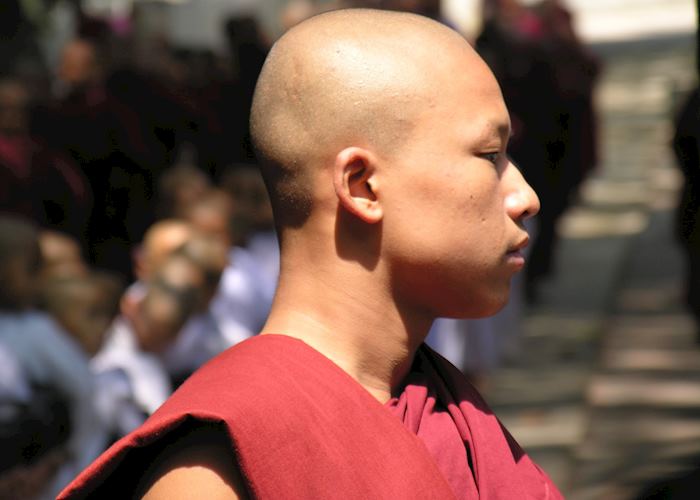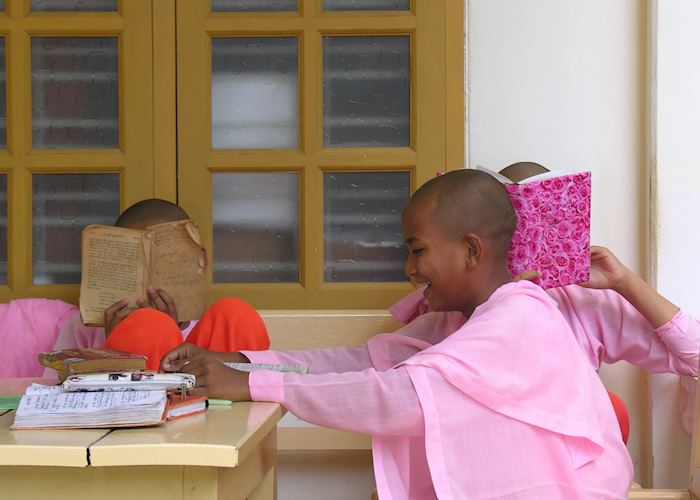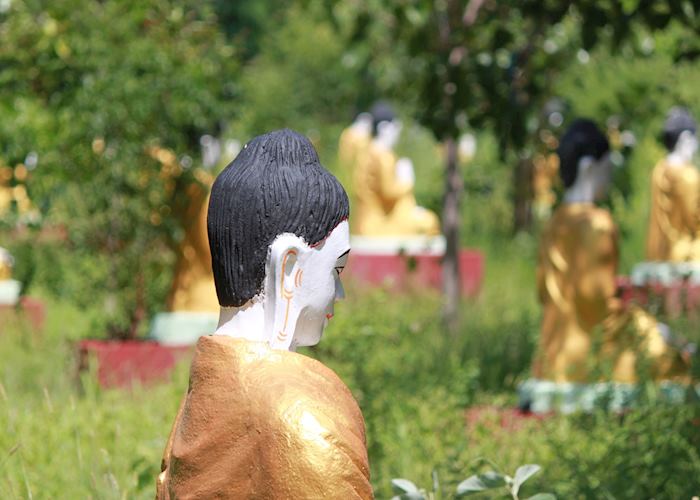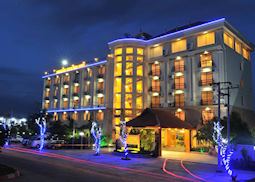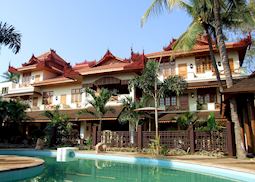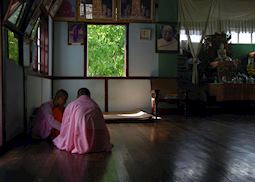Jump to:
Rudyard Kipling yearned for Myanmar’s ‘sunshine an' the palm-trees an' the tinkly temple-bells’ in his poem Mandalay. He never actually made it to the city, but if he had, he’d have seen the palaces and royal pagodas of Myanmar’s last royal capital, created by King Mindon in 1857. But, he’d have missed its heyday — in 1886, the expanding British Empire claimed the city, sent the royal family into exile and moved the capital to Rangoon (now Yangon).
His romantic view is now a distant echo: in 1942, the city was bombed flat. Modern Mandalay has since risen from the ashes in a haphazard building boom that won’t win any architecture awards. But, its people have clung to their heritage, making this a lively, vibrant metropolis where the temple bells still tinkle.
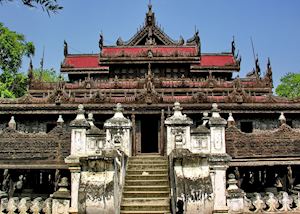 Mandalay is an important religious hub, with more Buddhist monasteries than anywhere else in the country. Originally, the Shwenandaw Monastery was part of the royal palace and living quarters of King Mindon. After his death, his son, Thibaw Min, relocated it outside the palace walls, convinced his father’s spirit was haunting it. This fear of the supernatural saved the monastery from destruction in World War II (although its nickname, Golden Palace Monastery, began to fade as occupying British troops pillaged the gold from its walls).
Mandalay is an important religious hub, with more Buddhist monasteries than anywhere else in the country. Originally, the Shwenandaw Monastery was part of the royal palace and living quarters of King Mindon. After his death, his son, Thibaw Min, relocated it outside the palace walls, convinced his father’s spirit was haunting it. This fear of the supernatural saved the monastery from destruction in World War II (although its nickname, Golden Palace Monastery, began to fade as occupying British troops pillaged the gold from its walls).
This remnant of Mandalay’s regal heritage is the finest surviving example of a Burmese 19th-century carved wooden monastery, and an insight into what the original palace may have looked like. A replica of the Royal Palace was built in the early 1990s using the original plans, and you can now wander among the red-roofed pagodas, throne rooms and audience halls. Look out for the charred steps of the Royal Mint — one of the few surviving original buildings.
The royal family were great patrons of finely crafted goods, and Mandalay has long been a focal point for art and handicrafts. The workshops are open to visitors, where you can see hunks of marble being sculpted into Buddha, the fine carving of teak wall panels, and families who still practise the age-old art of Burmese puppetry. Visit a gold-leaf workshop and you’ll see the gold being manually hammered into fine sheets.
At Mahamuni Pagoda, you can see where most of that gold leaf goes. The pagoda enshrines a 4 m (13 ft) bronze Buddha, which has been covered in so much gold it has lost its original proportions. For Buddhists, worship often involves rubbing a square of gold leaf onto a statue — some smaller statues morph into gold rocks over time. The complex also contains a few bronze statues claimed as war loot from Angkor Wat in the 15th century.
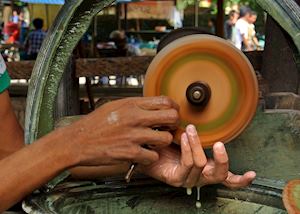 Much of the gold leaf is also used to make jewellery, which you can see in Mandalay’s many markets. The Jade Market is the largest of its kind in Myanmar, and inside you’ll find traders haggling over and hawking their wares while craftspeople cut and polish the jade.
Much of the gold leaf is also used to make jewellery, which you can see in Mandalay’s many markets. The Jade Market is the largest of its kind in Myanmar, and inside you’ll find traders haggling over and hawking their wares while craftspeople cut and polish the jade.
The stalls of the open-air Thaye Zay Station Bazaar pop up on and around a running train track. Visit in the morning and you might catch the many fruit and vegetable sellers moving their produce to make way for a passing train or two.
To get a feel for Mandalay’s geography, you can climb Mandalay Hill, the only defining feature on an otherwise flat landscape. There are four routes, one on each side of the hill, and the covered southern stairway passes through a number of temples and pagodas. From the top, you can see the Irrawaddy glistening in the distance.
Located near the foot of Mandalay Hill is the Kuthodaw Pagoda. The golden stupa is surrounded by hundreds of smaller shrines set in concentric squares. Each shrine holds a marble slab inscribed with Burmese script. Together, these 729 slabs contain the entire Buddhist text Tripitaka, making the temple complex one giant book — the largest ever written.
Best time to visit Mandalay
The best time to go to Mandalay tends to be from November to February, when temperatures hover at a comfortable 30°C (86°F) and there’s little rain. April and May are typically the hottest months, and in late May the monsoon season brings rain. If you don’t mind a few showers, September and October can be quieter, as the monsoon rains subside.
who's been there
-
01993 838 92501993 838 105
- Make an enquiry
Places near Mandalay
- Monywa 62 miles away
- Pindaya 82 miles away
- Hsipaw 90 miles away
- Mount Popa 91 miles away
- Bagan 98 miles away
- Kalaw 99 miles away
- Nyaung Shwe 107 miles away
- Inle Lake 114 miles away
- Lashio 126 miles away
- Mindat 142 miles away
- Kanpetlet 142 miles away
- Bhamo 174 miles away
- Loikaw 176 miles away
- Mrauk U 210 miles away
- Kyaingtong 232 miles away
- Ngapali Beach 271 miles away
Photos of Mandalay
Accommodation choices for Mandalay
We've selected a range of accommodation options for when you visit Mandalay. Our choices usually come recommended for their character, facilities and service or location. Our specialists always aim to suggest properties that match your preferences.
-
![Ayeyarwaddy River View Hotel, Mandalay]()
Ayeyarwady River View Hotel
Mandalay -
![Villa at Yadanarpon Dynasty Hotel, Mandalay]()
Yadanarpon Dynasty Hotel
Mandalay -
![Swimming pool at the Mandalay Hill Resort, Mandalay]()
Mandalay Hill Resort
Mandalay -
![Lobby Mandalay City Hotel, Mandalay]()
Mandalay City Hotel
Mandalay -
![The Red Canal, Mandalay]()
Hotel by the Red Canal
Mandalay
Ideas for experiencing Mandalay
Our specialists seek out authentic ways to get to know the places that could feature in your trip. These activities reflect some of the experiences they've most enjoyed while visiting Mandalay, and which use the best local guides.
-
Monywa’s sandstone caves ![Bodhi Tataung, Monywa]()
Monywa’s sandstone caves
Monywa’s sandstone caves
The drive to Monywa is 140 kilometres from Mandalay and takes around four hours. It is possible to make various stops along the way which would increase the length of the journey to around six hours.
View details -
Experience Sagaing’s spiritual side ![Sagaing is home to over 10,000 practicing monks and nuns, Burma (Myanmar)]()
Experience Sagaing’s spiritual side
Experience Sagaing’s spiritual side
Together with 15 resident nuns, you'll enjoy a simple lunch. After an early meal there will be time for a discussion with the nuns about their way of life, Buddhism and any other questions you might have.
View details -
Mandalay morning explorer ![Mandalay, Myanmar]()
Mandalay morning explorer
Mandalay morning explorer
Mandalay has a surprising amount to offer for those who know where to find it. This tour has been designed to reveal Mandalay from a diverse and interesting perspective.
View details





